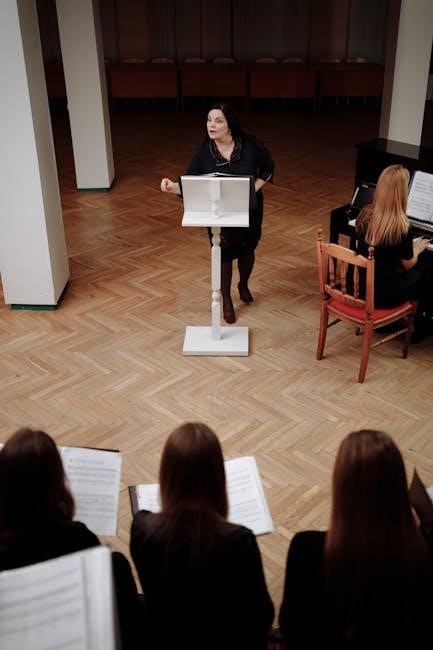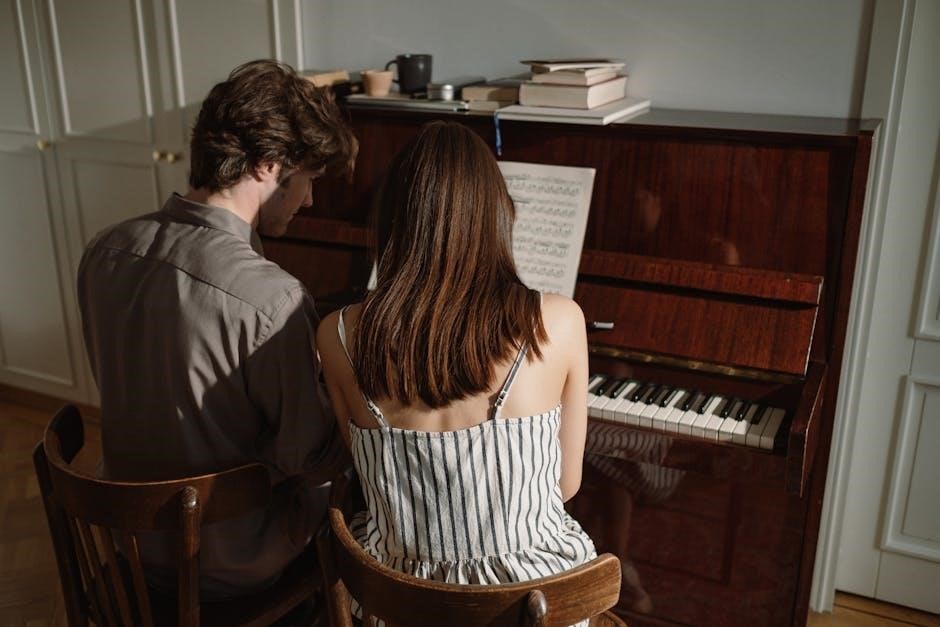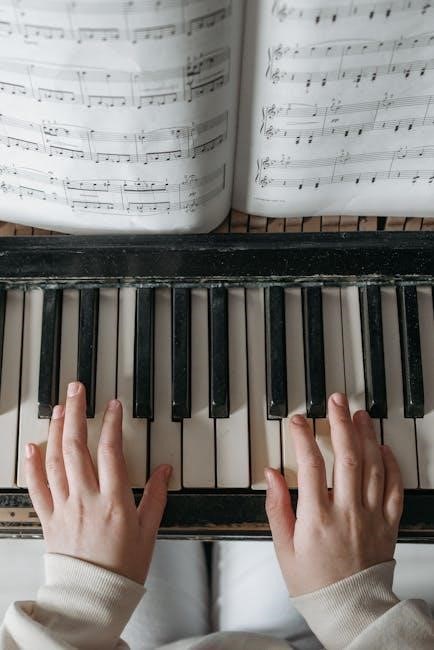Pachelbel’s Canon Sheet Music for Piano PDF: A Comprehensive Guide
Discover readily available, free Pachelbel Canon sheet music in PDF format, catering to all piano skill levels – from beginners to advanced players.
This guide explores resources for learning and enjoying this timeless Baroque masterpiece.
Historical Context of Pachelbel and the Canon
Johann Pachelbel, a prominent German Baroque composer and organist (1653-1706), flourished during a period of significant musical evolution. While prolific during his lifetime, composing cantatas, hymn settings, and chamber sonatas – particularly for violin – he is overwhelmingly remembered today for a single work: the Canon in D.
Interestingly, despite its current ubiquitous presence, especially at weddings, the Canon wasn’t widely celebrated immediately after its composition, likely around 1680. It existed initially as part of a larger set of 24 variations on a single bassline. The original instrumentation wasn’t for solo piano, but rather for three violins and basso continuo – a harmonic foundation typically played by a cello or bass instrument alongside a harpsichord or organ.

Its resurgence in popularity is a relatively recent phenomenon, gaining traction in the 20th century through various arrangements and its frequent use in popular culture. The availability of piano sheet music, particularly in easily accessible PDF format, has further fueled its enduring appeal and made it a staple for piano students worldwide.
The Original Instrumentation of the Canon in D

Pachelbel’s Canon in D wasn’t initially conceived as a standalone piano piece. Its genesis lies in a chamber music setting, specifically scored for three violins and basso continuo. This foundational harmonic support was traditionally provided by a cello, viola da gamba, or bassoon, coupled with a keyboard instrument like a harpsichord or organ realizing the figured bass.
The three violins engage in a captivating interplay, each mirroring the melodic line at different intervals, creating the iconic canon effect. The basso continuo provides a stable harmonic foundation upon which the violin lines weave their intricate patterns. This original arrangement highlights the Baroque era’s emphasis on counterpoint and harmonic clarity.
The transition to piano arrangements, readily available today as PDF sheet music, represents a significant adaptation. While preserving the harmonic structure, piano versions often simplify or redistribute the violin parts for a single instrument. Understanding the original instrumentation provides valuable context when interpreting and performing these piano adaptations.
Why the Canon in D is Popular for Piano
The Pachelbel Canon’s enduring appeal on the piano stems from its inherent beauty and accessibility. Despite its Baroque origins, the harmonic simplicity and repetitive structure make it surprisingly approachable for pianists of varying skill levels. Numerous piano arrangements, available as PDF sheet music, cater to beginners with simplified versions and challenge advanced players with intricate embellishments.
Its calming and recognizable melody contributes significantly to its popularity, particularly at weddings and other ceremonial events. The piece’s soothing quality makes it ideal for relaxation and background music. The availability of free and affordable sheet music PDFs further democratizes access, allowing anyone to learn and perform this classic.
Furthermore, the Canon provides excellent practice for fundamental piano techniques, including arpeggios, chord progressions, and hand coordination. Its widespread recognition ensures an appreciative audience, making it a rewarding piece to master.
Availability of Free Pachelbel Canon Sheet Music PDF
A wealth of free Pachelbel Canon sheet music in PDF format is readily accessible online, catering to diverse piano proficiencies. Numerous websites host digital scores, ranging from simplified arrangements for beginners to complex transcriptions for advanced pianists. These resources boast a vast collection, with over 1.5 million digital sheet music options available for download.
Many platforms offer both standard notation and chord charts, facilitating learning and improvisation. The ease of access allows musicians, students, and teachers to quickly obtain and utilize the music. However, it’s crucial to verify the legality and usage rights of these free resources, ensuring compliance with copyright regulations.
Popular sites dedicated to sheet music distribution frequently feature the Canon in D, alongside arrangements for various instruments. This widespread availability contributes to the piece’s continued popularity and accessibility for aspiring pianists worldwide.
Legality and Usage Rights of Free Sheet Music
Navigating the world of free Pachelbel Canon sheet music PDFs requires careful attention to legality and usage rights. While abundant resources exist, not all are legitimately distributed. Many free scores are offered with stipulations, often restricting commercial use – meaning performance for profit or inclusion in published materials.
It’s essential to understand that copyright laws protect musical compositions, even those in the public domain. Some free PDFs may be unauthorized copies, potentially infringing on copyright. Always prioritize sources that explicitly state permissible usage, such as “for personal practice only;”
Websites offering free sheet music often rely on user-submitted content, increasing the risk of inaccurate or illegal uploads. Responsible musicians should verify the source’s credibility and respect intellectual property rights. Utilizing legally obtained sheet music supports composers and ensures the continued creation of musical works.
Different Piano Arrangements: Beginner vs. Advanced
Pachelbel’s Canon, while seemingly simple, exists in a spectrum of piano arrangements catering to diverse skill levels. Beginner arrangements typically simplify the harmonic structure, often utilizing only the core melody and basic chord progressions in the right hand, with simplified left-hand accompaniment.

These versions frequently omit ornamentation and complex voicings, focusing on readability and ease of execution. Advanced arrangements, conversely, delve into the intricacies of the original composition. They incorporate fuller harmonies, elaborate counterpoint, and more challenging rhythmic patterns.

Advanced pianists can explore arrangements that faithfully recreate the original instrumentation’s texture, including elements of the basso continuo. These arrangements demand a strong understanding of music theory and advanced piano technique. Choosing the appropriate arrangement is crucial for a rewarding learning experience, ensuring both enjoyment and musical growth.
Understanding the Time Signature (4/4) and Key (D Major)
Pachelbel’s Canon in D is fundamentally rooted in a 4/4 time signature, meaning each measure contains four beats, with the quarter note receiving one beat. This creates a steady, predictable pulse that underpins the piece’s serene character. Understanding this rhythmic foundation is vital for accurate performance and interpretation.
The piece is written in D Major, a key known for its bright and optimistic quality. This key signature features two sharps (F# and C#), influencing the melodic and harmonic content. Familiarity with the D Major scale and its associated chords – D, Em, F#m, G, A, Bm – is essential for navigating the sheet music.
Recognizing these elements allows pianists to anticipate harmonic changes and execute the piece with greater confidence and musicality. Mastering the 4/4 time and D Major key unlocks a deeper appreciation for Pachelbel’s compositional genius.
Key Features of Baroque Music in the Canon
Pachelbel’s Canon beautifully exemplifies core characteristics of Baroque music. A prominent feature is the use of counterpoint – independent melodic lines interwoven harmoniously. The Canon’s repeating bass line, known as the basso continuo, provides a harmonic foundation upon which the melodic variations unfold.
Terraced dynamics, a hallmark of the Baroque era, are present, with sudden shifts in volume rather than gradual crescendos or diminuendos. Ornamentation, though often added by performers today, was also common, embellishing the melodic lines. The piece’s structure, built on a repeating harmonic progression, is typical of Baroque compositional techniques.

The Canon’s clarity and balance, prioritizing melodic development and harmonic structure, are quintessential Baroque traits. Studying these features enhances understanding and appreciation of Pachelbel’s masterful application of Baroque musical principles within this iconic composition.
The Role of Basso Continuo in the Original Composition
In Pachelbel’s original Canon in D, the basso continuo was fundamental. This wasn’t a single instrument, but rather a harmonic foundation typically played by a cello, bass viol, or bassoon, alongside a keyboard instrument like a harpsichord or organ.
The keyboard player didn’t simply play the written bass line; they “realized” it, improvising harmonies above the given notes, filling out the chordal structure. This realization was guided by figured bass – numbers and symbols indicating the desired harmonies. The basso continuo provided the harmonic drive and rhythmic pulse for the entire piece.
When adapting the Canon for piano, the left hand often takes on the role of the basso continuo, providing a similar harmonic support. Understanding its original function is crucial for interpreting and performing the piece authentically, even in simplified piano arrangements. It’s the bedrock upon which the melodic beauty rests.

Finding Reliable Sources for Piano Sheet Music PDFs
Locating trustworthy sources for Pachelbel’s Canon sheet music PDFs requires careful consideration. Numerous websites offer free downloads, but quality and legality vary significantly. Reputable music libraries and educational institutions often provide access to well-edited, public domain scores.
Websites dedicated to sheet music, like IMSLP (International Music Score Library Project), are excellent starting points, offering verified, public domain editions. Be cautious of sites with unclear copyright information or those hosting numerous arrangements of questionable origin. Always check for accuracy – compare multiple sources if possible;
Prioritize PDFs that are clearly legible, properly formatted, and free of errors. Consider the arrangement’s difficulty level and ensure it aligns with your piano skills. Remember to respect copyright laws and support composers by purchasing sheet music when appropriate.
Websites Offering Free Pachelbel Canon Sheet Music
Several online platforms provide free Pachelbel Canon sheet music in PDF format. IMSLP (International Music Score Library Project) stands out as a premier resource, offering public domain scores meticulously verified for accuracy. Musicnotes.com often features free sample arrangements, though full versions may require purchase.
Sheetmusicplus.com and Virtualsheetmusic.com also host a selection of free Canon in D arrangements, ranging in difficulty. Many individual websites and blogs dedicated to piano music offer downloadable PDFs, but exercise caution regarding copyright and quality.
Pinterest can lead to various free sheet music links, but verification is crucial. Remember to always scan downloaded files for viruses and prioritize sites with clear terms of use. Exploring these resources unlocks a wealth of options for accessing this beloved Baroque piece.
Sheet Music Difficulty Levels: Assessing Your Skill
Pachelbel’s Canon sheet music for piano appears in a wide spectrum of difficulty levels, catering to diverse skill sets. Beginner arrangements typically simplify the harmonies and melodic lines, often utilizing single-note melodies and basic chord progressions. These versions prioritize accessibility over intricate detail.
Intermediate sheet music introduces more complex chord voicings, arpeggiated figures, and potentially a slightly faster tempo. Players at this level should possess a solid foundation in piano technique and music theory. Advanced arrangements faithfully recreate the original Baroque texture, demanding proficient sight-reading, finger dexterity, and a nuanced understanding of musical phrasing.
Before selecting a PDF, honestly assess your current abilities. Starting with an easier version builds confidence and prevents frustration. Consider factors like hand independence, rhythmic complexity, and the presence of ornamentation when gauging suitability.
Tips for Learning the Canon on Piano
Successfully learning Pachelbel’s Canon on piano requires a strategic approach. Begin by mastering the foundational bass line – the repeating chord progression is crucial. Practice it slowly and consistently until it becomes automatic. Then, gradually introduce the melodic lines, focusing on accuracy and evenness of touch.
Break the piece into smaller sections. Don’t attempt to learn the entire Canon at once; focus on manageable phrases. Utilize a metronome to develop a steady tempo and rhythmic precision. Pay close attention to dynamics and phrasing to capture the Baroque style’s elegance.
Listen to recordings of the Canon frequently to internalize the musicality. Consider practicing hands separately before combining them. Don’t be afraid to simplify sections initially, gradually adding complexity as your skills improve. Patience and consistent practice are key!

Common Challenges and How to Overcome Them
Many pianists encounter challenges when learning Pachelbel’s Canon. A frequent hurdle is coordinating the independent melodic lines; practice hands separately, then slowly combine them, focusing on rhythmic alignment. The repetitive nature, while beautiful, can lead to monotony – vary your practice by focusing on different voices each time.

Maintaining a consistent tempo throughout the piece can be difficult. Utilize a metronome diligently, starting at a slow speed and gradually increasing it as you gain confidence. Finger dexterity is also crucial; practice scales and arpeggios to improve your technique.
Don’t get discouraged by the length of the piece! Break it down into smaller, achievable sections. If you struggle with a particular passage, slow down significantly and isolate the problematic notes or chords; Consistent, focused practice will yield results.
Beyond the Canon: Other Notable Works by Pachelbel
While universally recognized for his Canon in D, Johann Pachelbel composed a substantial and diverse body of work. Exploring these pieces reveals a prolific composer beyond this single, iconic melody. Notably, his Chaconne in F minor for organ demonstrates his mastery of variation form, offering a compelling and emotionally resonant experience.
The Toccata in E minor, also for organ, showcases Pachelbel’s virtuosic skill and improvisational flair. Furthermore, the Hexachordum Apollonis, a set of keyboard variations, presents a challenging yet rewarding exploration of Baroque counterpoint. These works, though less frequently performed than the Canon, provide valuable insight into Pachelbel’s compositional style.
Discovering these pieces expands appreciation for Pachelbel’s contributions to Baroque music and offers pianists alternative repertoire to explore, enriching their musical journey beyond the familiar Canon.
The Canon in D at Weddings and Other Events
Pachelbel’s Canon in D has become a ubiquitous choice for weddings, symbolizing elegance and timeless romance. Its gentle, flowing melody provides a beautiful backdrop for processions, ceremonies, and receptions, frequently arranged for solo piano or ensemble performances. The piece’s calming and harmonious nature contributes to a serene atmosphere.
Beyond weddings, the Canon’s versatility extends to various events, including corporate functions, concerts, and even film soundtracks. Its recognizable tune evokes a sense of sophistication and tranquility, making it suitable for diverse settings. Many pianists offer arrangements specifically tailored for event performances, often available as PDF sheet music.
The enduring popularity of the Canon stems from its emotional resonance and accessibility, solidifying its place as a beloved classic for both formal and informal occasions.
Variations and Adaptations of the Canon for Piano
While the original Canon in D is for three violins and basso continuo, countless piano variations and adaptations exist, readily available as PDF sheet music. These range from simplified arrangements for beginners to complex, virtuosic interpretations for advanced pianists. Many arrangements incorporate embellishments, harmonies, and rhythmic alterations.
Some adaptations feature jazz harmonies, pop influences, or even electronic elements, demonstrating the Canon’s adaptability across genres. You can find versions transcribed for piano solo, piano duet, or piano accompaniment with other instruments. Sheet music often includes different levels of difficulty, indicated by grading systems.
Exploring these variations offers pianists a chance to personalize the Canon and showcase their musicality. The availability of diverse PDF sheet music ensures there’s an arrangement to suit every skill level and artistic preference, fostering creativity and enjoyment.
Printing and Formatting Pachelbel Canon Sheet Music PDFs
When downloading Pachelbel Canon sheet music PDFs, proper printing and formatting are crucial for readability and a positive learning experience. Ensure your PDF viewer allows scaling options to fit the sheet music appropriately onto your chosen paper size – typically A4 or Letter.

Experiment with different scaling percentages to avoid cramped or excessively large notation. Consider printing in landscape orientation for wider measures and reduced page breaks. Black and white printing is generally sufficient, but color can highlight phrasing or dynamics if present in the PDF.
For optimal clarity, use a high-resolution printer and quality paper. Some PDFs may require adjustments to margins or page orientation within your printer settings. Binding the printed sheets or using a sheet music folder keeps everything organized and prevents damage, enhancing practice sessions.
Software for Viewing and Editing PDF Sheet Music
Numerous software options are available for viewing and even editing Pachelbel Canon sheet music PDFs. Adobe Acrobat Reader is a standard, free choice for basic viewing and printing, offering zoom and page navigation features. For more advanced functionality, consider paid options like Adobe Acrobat Pro, enabling annotations, highlighting, and even minor edits to the PDF.
Alternatively, dedicated sheet music viewers like MuseScore or ForScore (iOS) provide specialized tools for musicians. These programs often include features like automatic page turns, metronome integration, and the ability to create setlists. Some software allows transposition, changing the key of the music to suit your preference.
Editing PDFs directly can be complex; specialized software like PDFelement offers more robust editing capabilities. However, be mindful of copyright restrictions when modifying sheet music. Choosing the right software depends on your needs – simple viewing or comprehensive editing and annotation.
